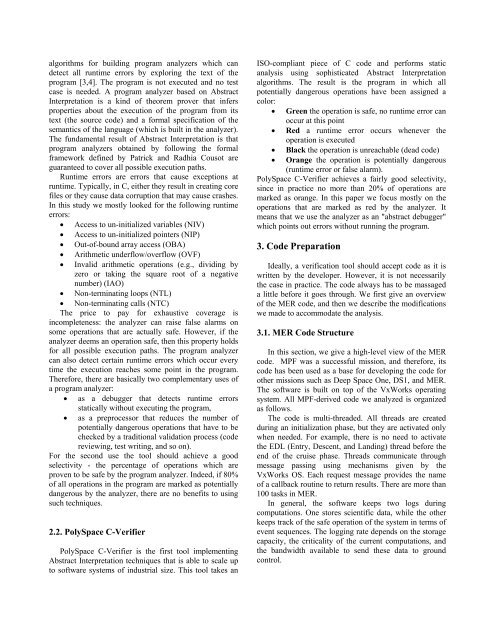Static Analysis of the Mars Exploration Rover Flight Software - NASA
Static Analysis of the Mars Exploration Rover Flight Software - NASA
Static Analysis of the Mars Exploration Rover Flight Software - NASA
You also want an ePaper? Increase the reach of your titles
YUMPU automatically turns print PDFs into web optimized ePapers that Google loves.
algorithms for building program analyzers which candetect all runtime errors by exploring <strong>the</strong> text <strong>of</strong> <strong>the</strong>program [3,4]. The program is not executed and no testcase is needed. A program analyzer based on AbstractInterpretation is a kind <strong>of</strong> <strong>the</strong>orem prover that infersproperties about <strong>the</strong> execution <strong>of</strong> <strong>the</strong> program from itstext (<strong>the</strong> source code) and a formal specification <strong>of</strong> <strong>the</strong>semantics <strong>of</strong> <strong>the</strong> language (which is built in <strong>the</strong> analyzer).The fundamental result <strong>of</strong> Abstract Interpretation is thatprogram analyzers obtained by following <strong>the</strong> formalframework defined by Patrick and Radhia Cousot areguaranteed to cover all possible execution paths.Runtime errors are errors that cause exceptions atruntime. Typically, in C, ei<strong>the</strong>r <strong>the</strong>y result in creating corefiles or <strong>the</strong>y cause data corruption that may cause crashes.In this study we mostly looked for <strong>the</strong> following runtimeerrors:• Access to un-initialized variables (NIV)• Access to un-initialized pointers (NIP)• Out-<strong>of</strong>-bound array access (OBA)• Arithmetic underflow/overflow (OVF)• Invalid arithmetic operations (e.g., dividing byzero or taking <strong>the</strong> square root <strong>of</strong> a negativenumber) (IAO)• Non-terminating loops (NTL)• Non-terminating calls (NTC)The price to pay for exhaustive coverage isincompleteness: <strong>the</strong> analyzer can raise false alarms onsome operations that are actually safe. However, if <strong>the</strong>analyzer deems an operation safe, <strong>the</strong>n this property holdsfor all possible execution paths. The program analyzercan also detect certain runtime errors which occur everytime <strong>the</strong> execution reaches some point in <strong>the</strong> program.Therefore, <strong>the</strong>re are basically two complementary uses <strong>of</strong>a program analyzer:• as a debugger that detects runtime errorsstatically without executing <strong>the</strong> program,• as a preprocessor that reduces <strong>the</strong> number <strong>of</strong>potentially dangerous operations that have to bechecked by a traditional validation process (codereviewing, test writing, and so on).For <strong>the</strong> second use <strong>the</strong> tool should achieve a goodselectivity - <strong>the</strong> percentage <strong>of</strong> operations which areproven to be safe by <strong>the</strong> program analyzer. Indeed, if 80%<strong>of</strong> all operations in <strong>the</strong> program are marked as potentiallydangerous by <strong>the</strong> analyzer, <strong>the</strong>re are no benefits to usingsuch techniques.2.2. PolySpace C-VerifierPolySpace C-Verifier is <strong>the</strong> first tool implementingAbstract Interpretation techniques that is able to scale upto s<strong>of</strong>tware systems <strong>of</strong> industrial size. This tool takes anISO-compliant piece <strong>of</strong> C code and performs staticanalysis using sophisticated Abstract Interpretationalgorithms. The result is <strong>the</strong> program in which allpotentially dangerous operations have been assigned acolor:• Green <strong>the</strong> operation is safe, no runtime error canoccur at this point• Red a runtime error occurs whenever <strong>the</strong>operation is executed• Black <strong>the</strong> operation is unreachable (dead code)• Orange <strong>the</strong> operation is potentially dangerous(runtime error or false alarm).PolySpace C-Verifier achieves a fairly good selectivity,since in practice no more than 20% <strong>of</strong> operations aremarked as orange. In this paper we focus mostly on <strong>the</strong>operations that are marked as red by <strong>the</strong> analyzer. Itmeans that we use <strong>the</strong> analyzer as an "abstract debugger"which points out errors without running <strong>the</strong> program.3. Code PreparationIdeally, a verification tool should accept code as it iswritten by <strong>the</strong> developer. However, it is not necessarily<strong>the</strong> case in practice. The code always has to be massageda little before it goes through. We first give an overview<strong>of</strong> <strong>the</strong> MER code, and <strong>the</strong>n we describe <strong>the</strong> modificationswe made to accommodate <strong>the</strong> analysis.3.1. MER Code StructureIn this section, we give a high-level view <strong>of</strong> <strong>the</strong> MERcode. MPF was a successful mission, and <strong>the</strong>refore, itscode has been used as a base for developing <strong>the</strong> code foro<strong>the</strong>r missions such as Deep Space One, DS1, and MER.The s<strong>of</strong>tware is built on top <strong>of</strong> <strong>the</strong> VxWorks operatingsystem. All MPF-derived code we analyzed is organizedas follows.The code is multi-threaded. All threads are createdduring an initialization phase, but <strong>the</strong>y are activated onlywhen needed. For example, <strong>the</strong>re is no need to activate<strong>the</strong> EDL (Entry, Descent, and Landing) thread before <strong>the</strong>end <strong>of</strong> <strong>the</strong> cruise phase. Threads communicate throughmessage passing using mechanisms given by <strong>the</strong>VxWorks OS. Each request message provides <strong>the</strong> name<strong>of</strong> a callback routine to return results. There are more than100 tasks in MER.In general, <strong>the</strong> s<strong>of</strong>tware keeps two logs duringcomputations. One stores scientific data, while <strong>the</strong> o<strong>the</strong>rkeeps track <strong>of</strong> <strong>the</strong> safe operation <strong>of</strong> <strong>the</strong> system in terms <strong>of</strong>event sequences. The logging rate depends on <strong>the</strong> storagecapacity, <strong>the</strong> criticality <strong>of</strong> <strong>the</strong> current computations, and<strong>the</strong> bandwidth available to send <strong>the</strong>se data to groundcontrol.
















